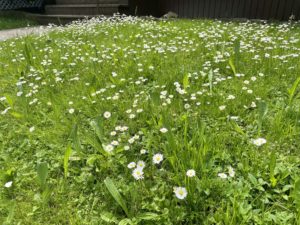For the second year in a row, environmentalists are asking people to NOT mow their lawns until at least June 1. The reason? Early springtime is when pollinators search for food in the form of small flowers. As plants are just starting to grow and bud, it’s important that bees (for example) are able to identify these critical food sources. When people get antsy to use their lawnmowers, that spells bad news for bees.
On Tuesday, February 14, grassroots activist Karima Bondi will be presenting virtually to Buffalo’s Common Council, and she is hoping that others that others that support the movement will be in attendance.
No Mow May is a conservation initiative that began in the United Kingdom in 2019. It has now spread to over 35 cities in the United States.
“Pollinators, especially bees and butterflies are in serious decline. These little creatures are indispensable. One third of every bite we eat is thanks to the work of pollinators,” stated Karima, who will be out of town during the Common Council meeting, but is asking for people to show their support for the initiative by attending in person. “We can help by refraining from mowing our lawns, or even a patch of our lawn, until June 1st. Many of the flowers we see in April and May, mainly daffodils and tulips, are hybrids, and offer little to no sustenance to pollinators. Studies have shown that properties participating in No Mow May have three to five times more pollinators than those that do not.
More broadly, No Mow May is asking us to rethink the ideal of the American lawn.
For decades, we have been told to mow the heck out of our lawns. This message has been brought to us by the lawn industry, as well as other peddlers of lifestyle propaganda. But now we’re starting to rethink important role that nature has in our lives. We depend on it to be healthy. And it depends on us to be healthy.
“Sadly, misinformation abounds. Some have concerns about rodents, ticks and allergies. Rodents, especially rats, are attracted to human food scraps and rarely nest in turf,” said Karima. “Grasses and wildflowers (dandelions, violets and clover) generally do not produce allergenic pollen. Ticks prefer wooded areas, but exercise common sense caution if you feel you are in an infected area.”
There was a time, not long ago, that a homeowner might be issued a ticket for an “unkempt” lawn that did not reflect a faux golf-course aesthetic. Thankfully those dark times and illogically imposed standards have changed.
“We are hoping for a resolution in which homeowners would not be cited or fined if they choose to leave their lawns, or even a portion of their lawns, unmowed in the month of May,” said Karima. “We want to protect a homeowners fundamental right to choose their own landscaping. There are NO RULES and NO MANDATES here. We want to live harmoniously with ALL our neighbors. This movement is more about raising awareness and stimulating conversations than it is about the height of our lawns. Buffalo has already made a name for itself as the largest free garden walk in the United States. Might we expand a positive perception of our city and add ourselves to the growing list of municipalities that are supporting No Mow May? It’s a low impact, high reward proposal. It may seem to be a small step, but it is an important one. We can make a vital difference.”
Common Council Meeting | 2/14/23 | 1:00PM | Buffalo City Hall | 13th Floor
Lead image: Example of a productive lawn in the late spring | Better yet, why not scrap your lawn altogether and transition it into a productive pollinator garden?
The post No Mow May II appeared first on Buffalo Rising.

